
Walk the Dog
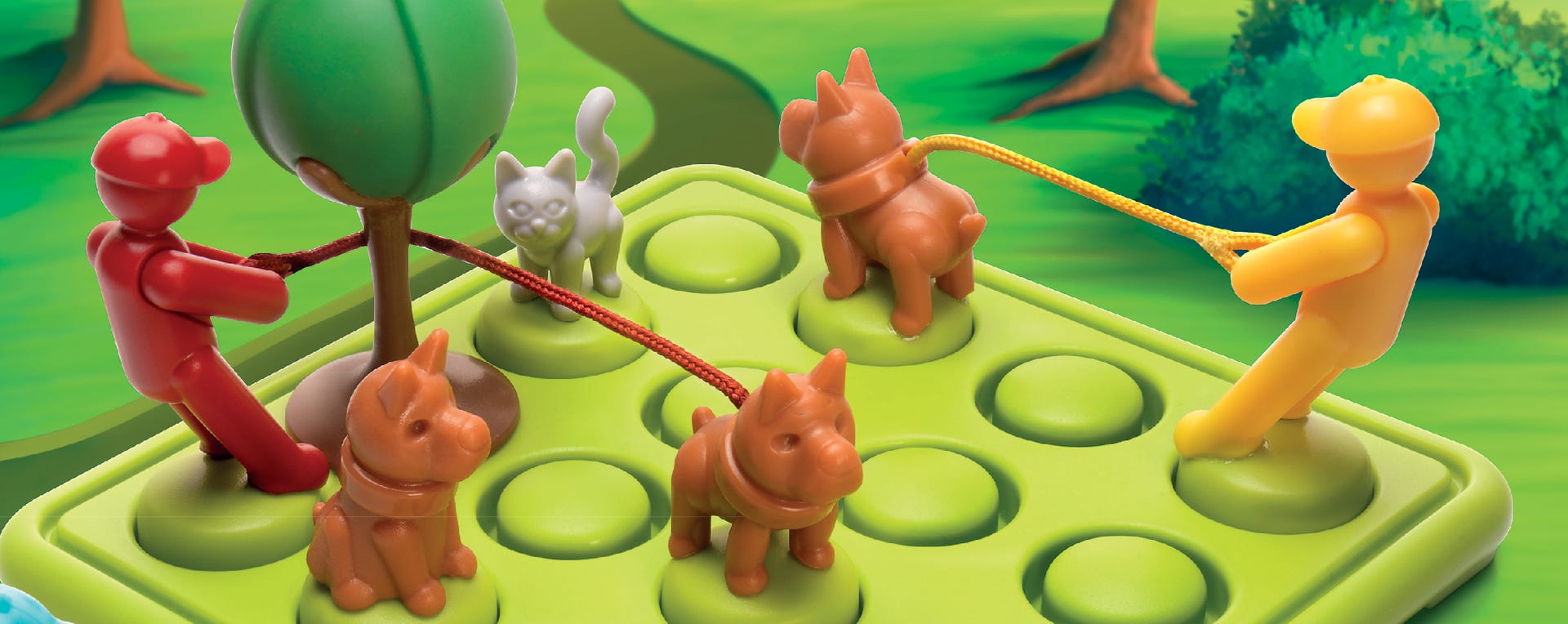
The product development of Walk the Dog (for SmartGames)
Raf Peeters, August 2020
When I design a puzzle for SmartGames, inspiration can come from anywhere. I am more a cat person than a dog person, so it was not really the animal that caught my interest. No, it was the dog leash and more specifically the “modern” version that can extend or retract. Already many years I wanted to do something in a puzzle with this idea of short and longer dog leashes, and this year I did.
WHO LET THE DOGS OUT?
In the begin I wanted to use dog leashes with lengths that could change, but soon realized that was technically too hard with such small figurines. So I changed the concept to 3 different walkers, each with a leash of a different length (1, 2 and 3). The game rules state that all leashes need to be under tension, because the dog and walker are both pulling hard in different directions. Therefor, you can’t just put every dog or person anywhere on the game board. Other restrictions are that dogs can’t be placed adjacent to other dogs or cats. On a conceptual level the dog-leash-walker combinations can be seen as a big puzzle piece with on one side a dog and on the other side a person. They only look as a puzzle pieces made of two parts, but they act as one single piece. It’s a bit similar to Noah’s Ark, except that now both parts are connected by a rope instead of a game rule.
DON’T GET TANGLED UP
But when there is a tree in the challenge, it becomes more like Penguins on Ice: some pieces can transform. The rope of the yellow and red person are long enough and can bend 90° around the tree. Challenges only show the positions of some walkers or dogs, so there are often a lot combinations to try out. Although there are many game rules (see complete game rules at the bottom of this page), they all make sense. So you only need to read them once, because they are easy to remember. When I was working on this project I saw a woman walking her dog in the park and exactly the thing that can happen in this game happened in reality: the dog run around a tree and the woman had to follow to avoid getting tangled up in the rope.
AVOID A FIGHT, KEEP THE LEASHES TIGHT!
One of the first versions of the program to calculate different challenges was already OK and produced enough interesting ones. Often, we need to try many different combinations of game boards, puzzle pieces and game rules, before we find a version that offers enough variation, but fortunately not this time. But we had other problems to overcome. That’s why this game is introduced in August and not in January like most other novelties. When the rope of the red and yellow persons bends around a tree it needs a slightly longer length because of the thickness of the tree trunk. Therefor the ropes are either too long when you use them as a straight line or too short when they need to bend. We tried for many months different options, one even more technical than the other. In the end we chose a very low tech solution. The figurines can tilt a little bit forward/backward, so that it always looks like the rope is under tension. So in case you wonder: the wobbling of the figurines is intentionally and not a design flaw ;-)
But the biggest problem was the packaging. Although the dogs and cats look kind of cute, the figurines are kept very basic, without much detail. This was needed for the concept. Because if a hint in a challenge shows the position of a person, this should point to any of the three people. So we could not give each person distinctive features. The downside of this design choice was the figurines look more like icons and less like cute people. So making a picture for the frontside of the packaging was a lot harder, because it didn’t look immediately “cute” like for example Squirrels Go Nuts. The solution was really a collaboration between people of the whole team. In the end we made a combination of a cartoonish logo with a product photo and an illustrated background that really works. Before we started I was afraid that we would never succeed in making this game very attractive, but in the end it is one of my favorites. Sometimes small details can make a big difference for the final result. For example we changed the dog leashes from black to color, which immediately looked a lot better.
This game never becomes extremely hard (it does not have a Wizard level), but I liked solving it, because most solutions can be deduced. I personally don’t like it when you need to work systematically and use trail and error to solve challenges. The game comes with a cotton “doggy bag” although I think most people will store it inside the cardboard box. The size of the game board is a little smaller than some other classic games, because originally it was intended to become a compact game. But my colleagues liked it so much that later in the development process we upgraded it to a classic game with 80 instead of 60 challenges. You can find a demonstration movie on the official Youtube channel of SmartGames.
UPDATE 2024: There is now a new compact SmartGame with a cute dog named Smart Dog. It’s a completely different type of puzzle, because it’s a connection game.
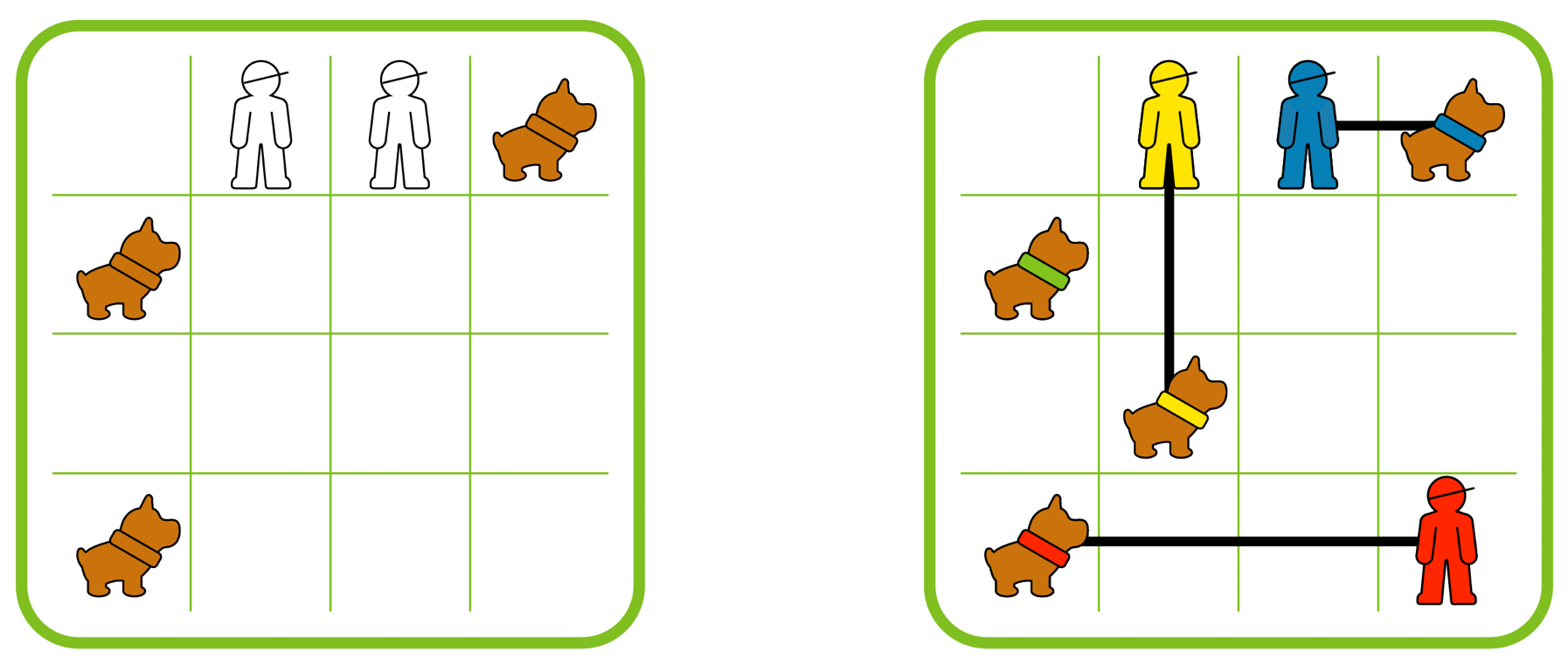
Easy example of a challenge (left) and solution (right) of Walk the Dog, without the tree or any cats.
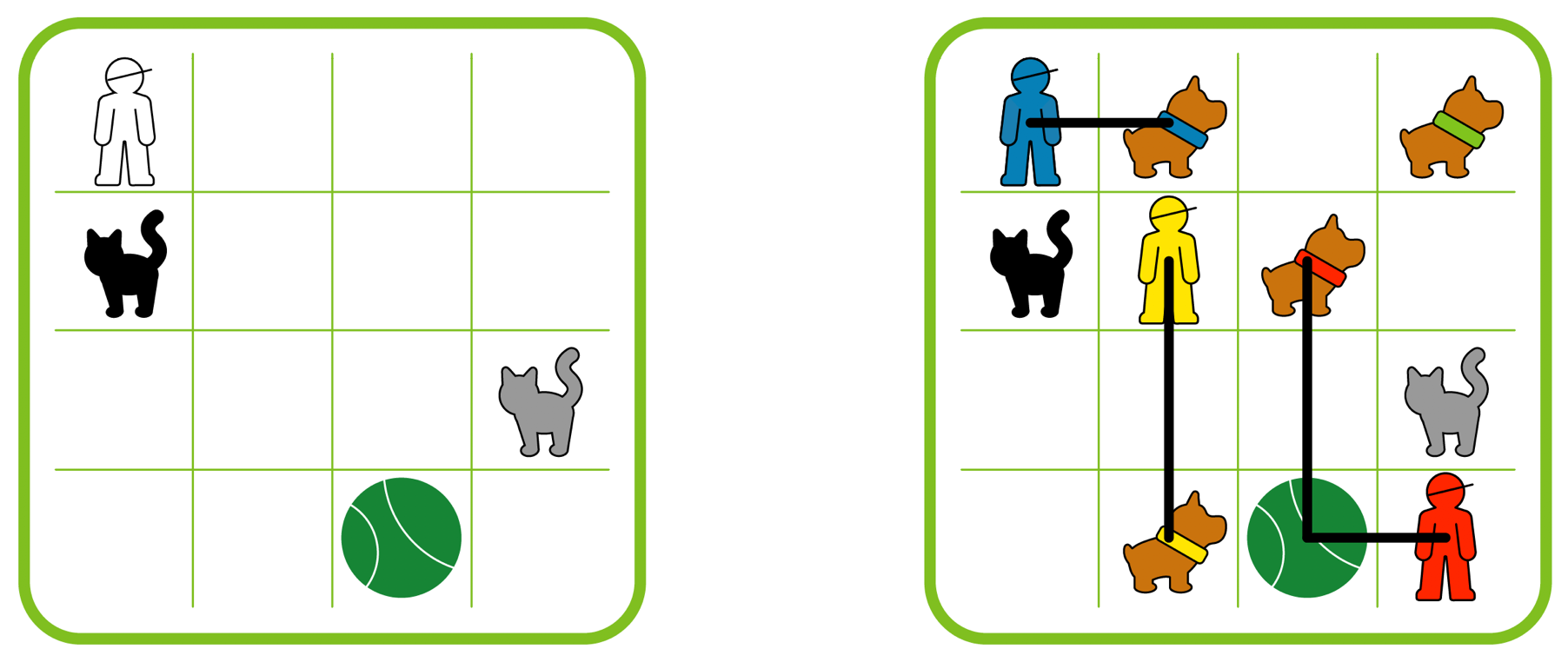
Difficult example of a challenge (left) and solution (right) of Walk the Dog with the tree and two cats.
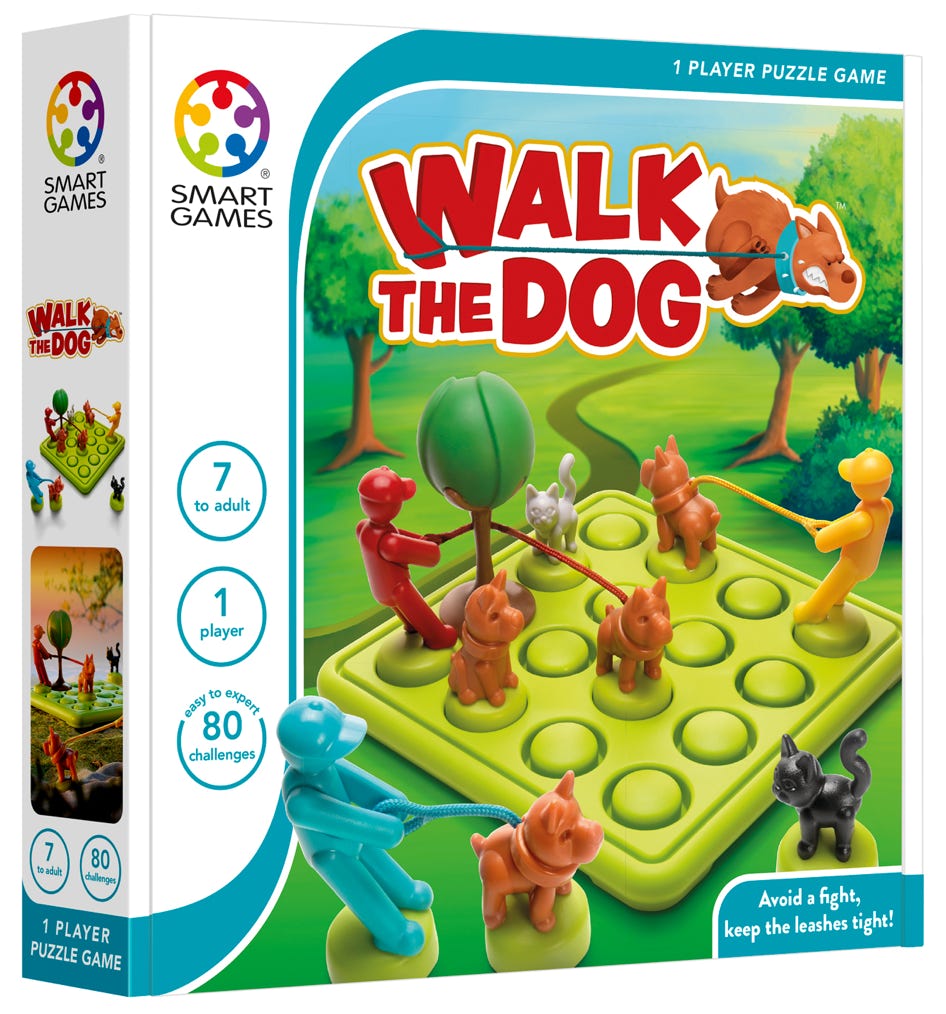
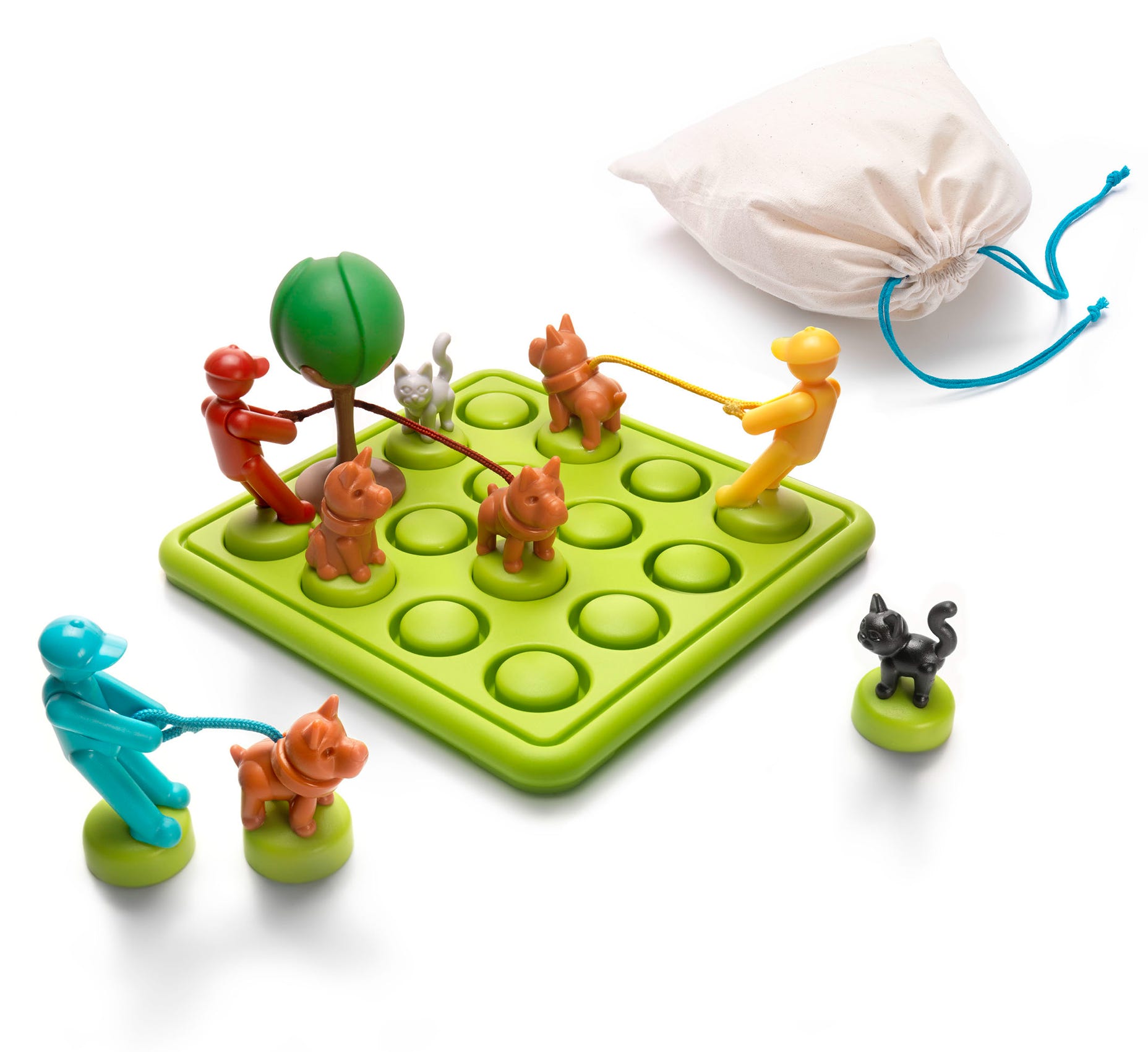
GAME RULES WALK THE DOG
The object of Walk the Dog is to place all 4 dogs in the park with enough space between them to avoid animal fights!
1. Select a challenge. Place the Cat(s) and tree on the game board, if needed. These pieces must remain in place on the board. If a Cat or tree is not shown in the challenge, you don’t need it in the solution.
2. Place all 4 dogs on the game board so that the solution follows the rules given in the challenge:
• A white Walker icon in the challenge indicates that a Walker must be placed on that spot on the gameboard. It can be any of the 3 Walkers.
• A Dog icon indicates that a dog must be placed on that spot. It can be any of the 4 Dogs.
• The orientation of the dogs and Walkers shown in the challenge is not relevant, only their position matters. Dogs and Walkers can have a different orientation in the solution than the one shown in the challenge.
• Earlier challenges sometimes give additional hints, such as the specific color of a Walker. More difficult challenges offer fewer hints about the position of the dogs and Walkers.
All Dogs must be placed on the game board, even when a challenge shows fewer than 4 Dogs! The remaining Dogs and Walkers can be placed anywhere on the board, following these rules:
A) Dogs can never be placed directly adjacent to other Dogs or Cats. This is how we avoid fights!
B) Three of the Dogs are always connected to a Walker by a leash. Leashes must form horizontal or vertical lines on the gameboard (diagonal lines are not allowed).
C) Leashes must always be straight and tense (the Dog is pulling hard, after all). The length of the connection is different for each Walker.
D) The leashes of the yellow and red Walkers can pass straight by or bend around the tree at a 90-degree angle.
E) Leashes can never cross each other or pass over Walkers, Dogs or Cats!
3. You have solved the challenge when all 4 Dogs are placed on the board according to these rules! There is only one solution, which can be found at the back of the booklet.
Website ©2024 Raf Peeters
Products and images: © Smart